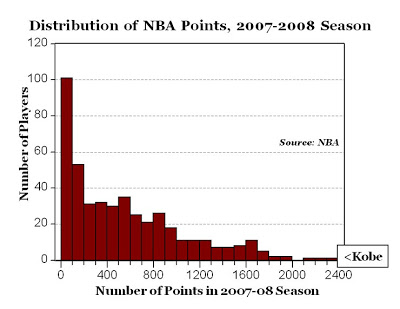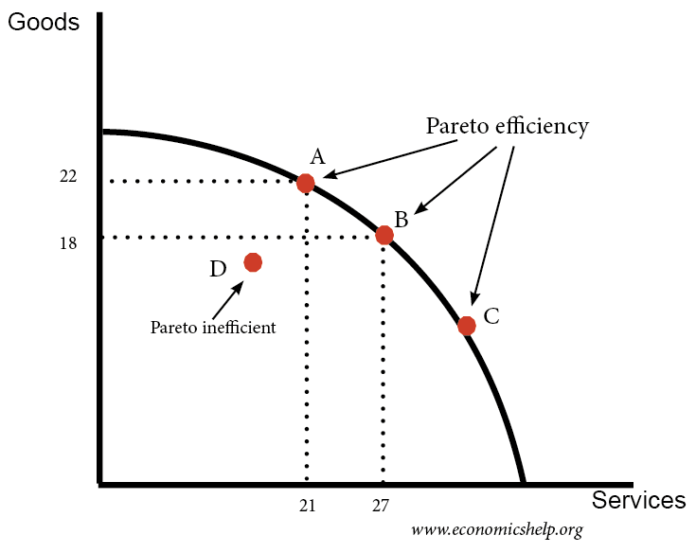Jordan Peterson teaches that all production occurs in a Pareto distribution, in which half of the output for a given group is produced by the square root of all participants. As such, if there are nine authors, three will produce half of the output. If there are 900 authors, 30 will produce half the output.
The pareto distribution does not break down, as you move up the pareto distribution, either. If there are 900 authors, 30 will produce half the output, and among those 30, 5 will produce half of their output (or a quarter the total). Of those five, two will produce half of their output (or an eighth of the total).
If only production followed a pareto distribution, the fact that that vast majority of production is concentrated on a small number of people would not be a problem, but income tends to follow production, and as a consequence, income follows a pareto distribution as well, meaning that half the income will go to the square root of the population, even if everyone is producing.
To put things into perspective, the United States has about 130 million full-time workers at any given time, in a population of about 330 million people. The square root of 130 million is 11,402, meaning that roughly half of all income, from full-time workers, in the United States, will be earned by around 11,402 people. The square root of 11,402 is 107, so a full quarter of all full-time worker income, in the United States, will go to around 107 people. The square root of 107 is 10, so one eighth of all income in the United States goes to around just ten people.
The early Soviets noticed that the vast majority of agricultural output came from a relatively small number of farmers, known as Kulaks, who owned their own farmland. The Soviets determined that the only way the Kulaks could grow so much more than could other farmers (who did not own their own land), was that they must have been essentially thieves, hoarding the best land for themselves. They solution was to send all of the Kulaks to the gulag system, where most of them died, and to redistribute the land among the other farmers (who did not own their own land). The result? Agricultural output collapsed, and millions of Russians starved to death over the next few years.
The Soviet experience with the Kulaks illustrates a very important point – when you lose (or kill, in the Soviet case) your most productive people, you also lose (or kill off) most of your production.
The public is largely split on whether or not the pareto problem is really a ‘problem,’ per se, as lots of people believe that income should follow production, and that the most productive among us should also be the richest among us. Lots of other people, of course, want incomes to be more equal than that.
Some economists have proposed (and the United States uses) progressive tax policies, in which we allow income inequality, but in which we also seize a growing proportion of income as someone moves up in the pareto distribution. Some want to go back to a 92% top marginal rate, which would take virtually everything someone makes, after a certain level of production has been achieved.
While some level of graduation in tax rates may be a good thing, if tax rates are too progressive (with top marginal rates that are too high), it can have a massive impact on production. The Scandinavian countries use high taxes on the poor and middle classes, and while the highest earners also pay high taxes in Scandinavia, the effective tax rate on income actually goes down as someone earns more. Scandinavia uses the tax revenue to provide a generous social welfare system, but what a lot of people don’t know is that the poor and middle classes are largely being supported with their own money. The United States, where people say the rich ‘do not pay their fair share,’ has the most progressive tax rates in the world.
It is also worth mentioning that the Scandinavian countries got to where they are through trial and error, and that this trial and error continues. Initially, the Scandinavian countries became wealthy through laissez faire capitalism (as did we). The Scandinavian countries did not have our constitutional protections, and as a result, they were able to go far more socialist than we ever have, far more quickly than we ever could, in the 1970s and 1980s, which led to economies on the verge of collapse.

Since the 1990s, the Scandinavian countries have been implementing sweeping free-market reforms. Sweden, as one example, has 100% school choice, based on a voucher program, for K-12 education, and has a privatized social security program. Sweden also have far fewer regulations on private businesses than do we, and the regulations they do have are far more transparent than are ours. Today, Sweden is looking at options to privatize their healthcare system, to make it more efficient, and to provide a higher quality of care.
The Scandinavian countries have also reduced welfare benefits, but not as quickly as they have rolled-back other forms of socialism, and they have shifted the tax burden more onto the backs of the poor and middle classes (to avoid reducing production levels), because they understand that discouraging people at the bottom of the pareto distribution from working has much less of an impact on total production than does discouraging production at the TOP of the pareto distribution. In other words, if someone who produces very little decides to produce less (or to produce nothing), the impact on total production is small, whereas if someone at the top of the pareto distribution does the same thing, the effect on production can be severe.
The question of how best to provide more for the bottom of the pareto distribution, without discouraging production at the top of the distribution, has never been answered, though the Scandinavian countries seem to show that finding an answer is possible.

Milton Friedman suggested a negative income tax. Under Milton Friedman’s plan, we would draw a line – say at $40,000 – and would subtract half of what someone makes from that amount. We would then give them half the difference.
As an illustration, someone making $7 an hour and working full time will earn almost exactly $15,000 per year (we’ll round to $15,000 to keep the math simple). If we subtract $15,000 from our line at $40,000 we get $25,000. We give this worker half of that, or $12,500. Since they earned $15,000 in the private economy, they take home $27,500 ($15,000 + $12,500). A family of four with two working parents would earn $55,000 at just $7 per hour, and would be out of poverty.
The IRS gives us the bureaucracy to run this program, and it would allow us to augment wages every time a worker is paid – just as we already do for those who pay federal income taxes. Better yet, under this program disadvantaged groups would be hired first rather than last, making this a program that would actually help people.
Of course, a ‘solution’ that only provides support for those who are unable to achieve a lifestyle of some pre-determined level on their own, will not eliminate the pareto distribution, nor ensure that everyone enjoys the spoils of our economic output equally, but it will ensure that two goals are met:
- Everyone is able to live within an acceptable lifestyle, and
- Everyone who is able contributes.
Doing anything more than providing for these two goals risks reducing total production, which in turn reduces the wealth available, but if we limit ourselves to these two goals (which I think the vast majority of us would call admirable), we can have a rational discussion about what constitutes an ‘acceptable lifestyle’.
Furthermore, by providing for whatever society determines is an ‘acceptable lifestyle’ (to full-time workers), we can eliminate other forms of government assistance, as those who can afford healthcare, food, and other necessities of life, do not need these things provided by government.
Our goal should not be to ‘solve’ the pareto problem, as it is not really a problem at all. Our goal should be to utilize the pareto distribution as an engine for further economic growth, such that a reasonable level of taxation can provide continually better outcomes for those who do need assistance. In such a way, we can eliminate poverty, and ensure that everyone who contributes, as they are able, gets at least a slice of the American Dream.
























[…] level thinkers understand that production follows a pareto distribution, in which half the output is produced by the square root of all participants. If you look at just […]
[…] level thinkers understand that production follows a pareto distribution, in which half the output is produced by the square root of all participants. If you look at just […]
[…] fact that production follows a pareto distribution exasperates this […]
[…] economy, and 3) a welfare state. Ironically, the most successful Social Democracies recognize that production and income both follow a Pareto Distribution, so they use regressive tax rates to pay for their welfare systems – something […]
[…] wrote, some time ago, about how production follows a Pareto Distribution, and you can read that here. Whether right, wrong, or indifferent, half of all production, across all fields, comes from the […]
[…] wrote, some time ago, about how production follows a Pareto Distribution, and you can read that here. Whether right, wrong, or indifferent, half of all production, across all fields, comes from the […]